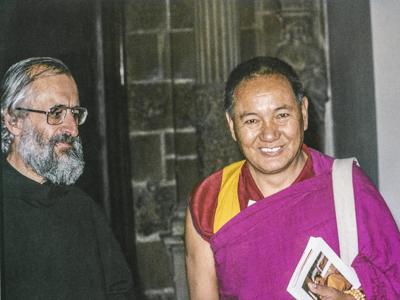So, he has left us, this marvellous being who was all smiles, who simply breathed goodness. I believe that I express the feeling of all those who knew him when I confess that I must hold back tears when I think that never again will I see that radiant face, filled both with a joy for life and awareness of suffering that affects the inner soul of all human beings. Others will tell of his past incarnations, the first stages in his monastic life, his studies in Tibet and the responsibilities that he took upon himself since exile. But please permit this Christian monk to recall a few memories of one who was for many both a master and a friend.
The first time we met was at La Sainte Baume in Provence, where for ten days, from 23rd September to 3rd October 1978, he gave his inspiration and energy to a Buddhist retreat for around 200 people. He was accompanying Zong Rinpoche whose more traditional style of teaching seemed a little distant. Of Lama Yeshe, however, one could only say that he had his audience in his pocket. He triumphed with his good satire of Western society. He was an incomparable stage artist, one might almost say a clown of frequently comic mimicry. And though he succeeded in laying bare the oddities and foolish ways, the delusions of the masses dominated by their passions, never did he hurt anyone. Rather, one felt touched by his unbelievable compassion and utter confidence in the inevitable victory of good. And when he gave himself up to fits of laughter, everyone would follow him, as though convinced that with this man at their side they were heading towards liberation.
I saw him again the following year during a second retreat at Viviers on the Rhone (l7th–3lst July 1979). Whilst Lama Zopa Rinpoche explained to us with simplicity and conviction the principal aspects of Mahayana philosophy, Lama Yeshe was once again possessed of an undeniable spiritual radiance.
Since then, it has always been a joy and a great blessing to meet him again. Whether on the poetic hill of Kopan beyond Boudnath in Nepal, or at his favourite refuge, Tushita, in the woods that rise above McLeod Ganj, not far from His Holiness the Dalai Lama, but higher than the lively hubbub of the Tibetan market. Thus he always placed himself close enough to the crowd to be good for him, but loving solitude where chosen disciples could follow him in initiations more secret and more severe. He was so good natured, yet still he knew how to keep to the demands of an arduous spiritual path. He would not allow such advanced retreats to take place without these conditions.
The fact that he made such an impression on the people he met almost by chance would in itself be sufficient. But behind those appearances of the benevolent father or sharp-witted child, there was an organiser of first rank. This can be judged simply by citing the large number of centres (more than thirty) that he founded, in most of the Western countries, for the ‘Preservation of the Mahayana Tradition’, from France to the United States, in Holland or in England, Spain, Italy and Australia. Wherever it was, he knew how to establish, to organize and to preserve. His passing away will now be mourned in all these many countries.
We know at what cost Lama Yeshe was able to persevere with his inexhaustible apostleship around the world in those final years. Considering the state of his heart, doctors would have condemned him to rest with no hope of recovery. And in addition to this, he suffered greatly from an ulcer in his stomach. But being such an ardent bodhisattva, he continued to give himself for welfare of all other beings.
And in addition to all this, may I, a Catholic monk, be permitted to allude to one essential characteristic of his being. He was a true ecumenist, knowing how to go beyond the traditional confines that so often separate the great religions. Need one recall what he did at Kopan for those retreaters who had come to learn the Buddhist techniques of meditation? One week before each Christmas, he delivered a series of discourses, more profound than one can begin to imagine, on the coming of Jesus to this world, the true meaning and the ways of preparation.
And during the retreat at La Sainte Baume, not only did he accompany a group of lamas to offer puja on top of the hill, in the grotto of Marie-Madeleine, but on another morning, he stole away with us to visit the church of Saint Maximin, where he professed a true devotion to Mary, Mother of Jesus. Everyone knows, however, how he remained the faithful propagator of Dharma and how he kept to his tradition. He would willingly recall the days at Lawudo, on the side of Mount Everest, where he educated his small monks so well.
Two years ago when he was finally able to undertake a pilgrimage to Tibet, he returned to his original monastery, the monastic university of Sera, where he had received his education in the college of Sera-je. In its present state of delapidation, the cell that he had formerly occupied no longer existed. Nevertheless, Lama Thubten Yeshe sat himself down in full lotus and remained there in meditation for many hours beneath the open sky.
I don’t know if it is appropriate to offer condolences in Buddhist circles. I think of his companion, so contemplative, so discreet, Lama Zopa Rinpoche, who was his disciple and who today must be feeling very lonely.































